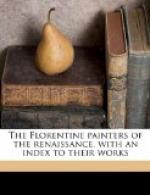XI.
[Page heading: LEONARDO]
All that Giotto and Masaccio had attained in the rendering of tactile values, all that Fra Angelico or Filippo had achieved in expression, all that Pollaiuolo had accomplished in movement, or Verrocchio in light and shade, Leonardo, without the faintest trace of that tentativeness, that painfulness of effort which characterised his immediate precursors, equalled or surpassed. Outside Velasquez, and perhaps, when at their best, Rembrandt and Degas, we shall seek in vain for tactile values so stimulating and so convincing as those of his “Mona Lisa”; outside Degas, we shall not find such supreme mastery over the art of movement as in the unfinished “Epiphany” in the Uffizi; and if Leonardo has been left far behind as a painter of light, no one has succeeded in conveying by means of light and shade a more penetrating feeling of mystery and awe than he in his “Virgin of the Rocks.” Add to all this, a feeling for beauty and significance that have scarcely ever been approached. Where again youth so poignantly attractive, manhood so potently virile, old age so dignified and possessed of the world’s secrets! Who like Leonardo has depicted the mother’s happiness in her child and the child’s joy in being alive; who like Leonardo has portrayed the timidity, the newness to experience, the delicacy and refinement of maidenhood; or the enchantress intuitions, the inexhaustible fascination of the woman in her years of mastery? Look at his many sketches for Madonnas, look at his profile drawing of Isabella d’Este, or at the Belle Joconde, and see whether elsewhere you find their equals. Leonardo is the one artist of whom it may be said with perfect literalness: Nothing that he touched but turned into a thing of eternal beauty. Whether it be the cross-section of a skull, the structure of a weed, or a study of muscles, he, with his feeling for line and for light and shade, forever transmuted it into life-communicating values; and all without intention, for most of these magical sketches were dashed off to illustrate purely scientific matter, which alone absorbed his mind at the moment.




